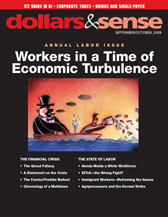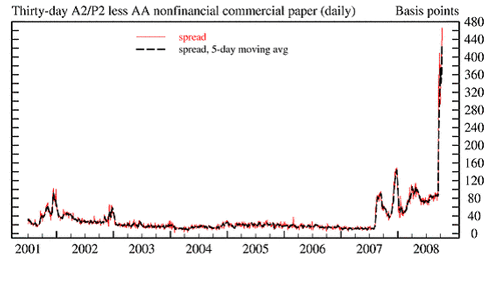Commercial Paper
Financialization’s (Latest) Weak Link
This is a web-only article from the website of Dollars & Sense: The Magazine of Economic Justice available at http://www.dollarsandsense.org

This is a web-only article, available only at www.dollarsandsense.org.
Subscribe Now
at a 30% discount.
There may be no better illustration of the staggering pain emanating from financial market turbulence than the carnage experienced recently in commercial paper markets worldwide. Commercial paper (often abbreviated as “CP” in the financial press) is not a synonym for trade journals or advertising-heavy publications of little intellectual value. “Commercial paper” is the term used for short-term loans—for less than 35 weeks— that are made without needing (in the United States) to be registered at the Securities and Exchange Commission (SEC). Companies raise money by selling repayment promises—IOUs—below the full value at the time of repayment. The difference between the price received by firms in the commercial paper market and the amount they pledge to pay is referred to as the “discount.” You may find large household name firms selling $1000 repayments in 90 days for between $960 and $980 today. A few months ago, firms were selling $1000 in 90 days for $990 or more. The discount has risen, as money has become hard to get. Most loans are for far less than 270 days, and loans average around one month’s duration. Trusted firms with good credit ratings can borrow—nearly at will—for low cost when markets function well. So commercial paper markets allow corporations fast and easy access to cash for operations, near-term expenses, and even payrolls. Consequently, commercial paper markets grew to a size of about $2 trillion, and this market became essential to the basic functioning of many firms—and hence to the whole economy.

Source: Federal Reserve, October 29, 2008 Release.
Commercial paper has become an attractive financing option for companies for other reasons, too. It allows access to large sums with less regulatory hassle, cost, or delay than tends to be the case with bond issuance or traditional commercial bank borrowing. In addition, as short-term interest rates have been very low in recent years, some companies couldn’t resist the temptation to borrow short and cheap with commercial paper and buy longer dated debt that paid higher interest rates. The difference was then a source of “earnings,” or revenue, for firms. This would turn out to be a dangerous game when short-term rates increased and credit became scarce. The short-term nature of the loans requires firms to roll them over, borrowing regularly. In other words, when you borrow for a short time, you need to borrow again soon.
What led to the current meltdown in this market? Of course, many factors come into play. The credit swoon began with a few firms extending (postponing) repayment on commercial paper. A similar situation actually occurred in August 2007. Back then, short-term loans in commercial paper markets had been used to finance mortgage-related investments, and the exploding of the subprime bubble triggered selling that drove short-term rates much higher, making continued borrowing or rollovers prohibitively expensive. But this fear subsided as weaker firms were forced out of the commercial paper market and confidence returned.
The present collapse of the commercial paper market originated with money market mutual funds. Money market mutual funds have been around for forty years. These funds manage cash from firms, charities, universities and individuals. Money market mutual funds make conservative short-term investment to guarantee that money is not lost. The focus on safety centers on the goal of never returning less than $1 for each $1 invested. In industry parlance, returning less than $1 is called “breaking the buck.” In the last four decades this has occurred only twice, and one of these times was September 16th, 2008.
The failure of Lehman Brothers on September 15th, 2008 capped a ten-day period that saw the Bank of America purchase of Merrill Lynch, the government takeover of Fannie Mae and Freddie Mac, and the bailout of AIG. The ensuing panic drove the value of a $1 investment in a money-market mutual fund called the Reserve Primary Fund to $ .97. Seized with fear that day, investors began withdrawing their money indiscriminately from money market mutual funds. Federal Reserve action led people to seek the safety of FDIC deposit insurance and US Treasuries. This diverted money from money market funds. Money market mutual funds were big, big buyers of commercial paper. Their exit from the CP market meant, in turn, a potential freeze-up in short-term funding for a large number of companies. Indeed, the situation got so bad that even the most highly regarded companies were largely unable to roll over their debts, and when they could do so, it was only for extremely short periods (sometimes one day). Such a situation, if prolonged, would bring effective corporate planning to an end.
The discounts required to borrow in the commercial paper market eventually doubled for stronger firms, and moved outside the realm of possibility for weaker or more suspect businesses. This led to an enormous decrease in the size of the CP market. From peak through trough, more than 90% of available funds dried up.
The Federal Reserve is leading the way in an attempt to jump-start the CP market. On October 7th, the New York Federal Reserve Bank announced the unveiling of its new Commercial Paper Funding Facility (CPFF). This new program will operate through private primary dealers, and began funding 90-day loans on October 27th. The program is set to run through April 30th, 2009. A “special purpose vehicle” (SPV) will buy the 90-day commercial paper and hold it to maturity. The funding will come from the New York Federal Reserve Bank, and the Pacific Investment Management Company (PIMCO) will manage the accounts. After a few wild days in the week of October 13th, rates began to slowly return to earth. This will be pivotal for positive movement in stock markets. The worst may be behind us; then again, we’ve hoped for that before.
The key lesson from the rapid demise of the all-important commercial paper market is that in an interdependent and financialized economy, markets interact. They can pass along opportunities, but they can also pass along fear, loss, and loathing. We have learned time and again that no man, market, or industry is an island. Commercial paper markets offer one more dramatic and violent example of mutual interdependence and risk.

